Influence of Titania Synthesized by Pulsed Laser Ablation on the State of Platinum during Ammonia Oxidation
Abstract
:Featured Application
Abstract
1. Introduction
2. Materials and Methods
2.1. Supports Preparation
2.2. Catalysts Preparation
2.3. X-ray Phase Analysis (XRD)
2.4. X-ray Absorption Spectroscopy (XANES, EXAFS)
2.5. X-ray Photoelectron Spectroscopy (XPS)
2.6. High Resolution Transmission Electron Microscopy (HRTEM)
2.7. Raman Spectroscopy
2.8. Catalytic Activity Measurements
3. Results
3.1. XRD Analysis
3.2. HRTEM Study
3.3. Raman Spectroscopic Analysis
3.4. XANES, EXAFS
3.5. XPS Analysis
3.5.1. Analysis of the Ti2p and O1s Core-Level Spectra
3.5.2. Analysis of Pt4f and Ti3s Spectral Region
3.5.3. Analysis of Pt4f Spectra
3.6. Temperature-Programmed Reduction (TPR-H2)
3.7. Catalytic Activity Measurements
4. Discussion
5. Conclusions
Author Contributions
Funding
Acknowledgments
Conflicts of Interest
Appendix A
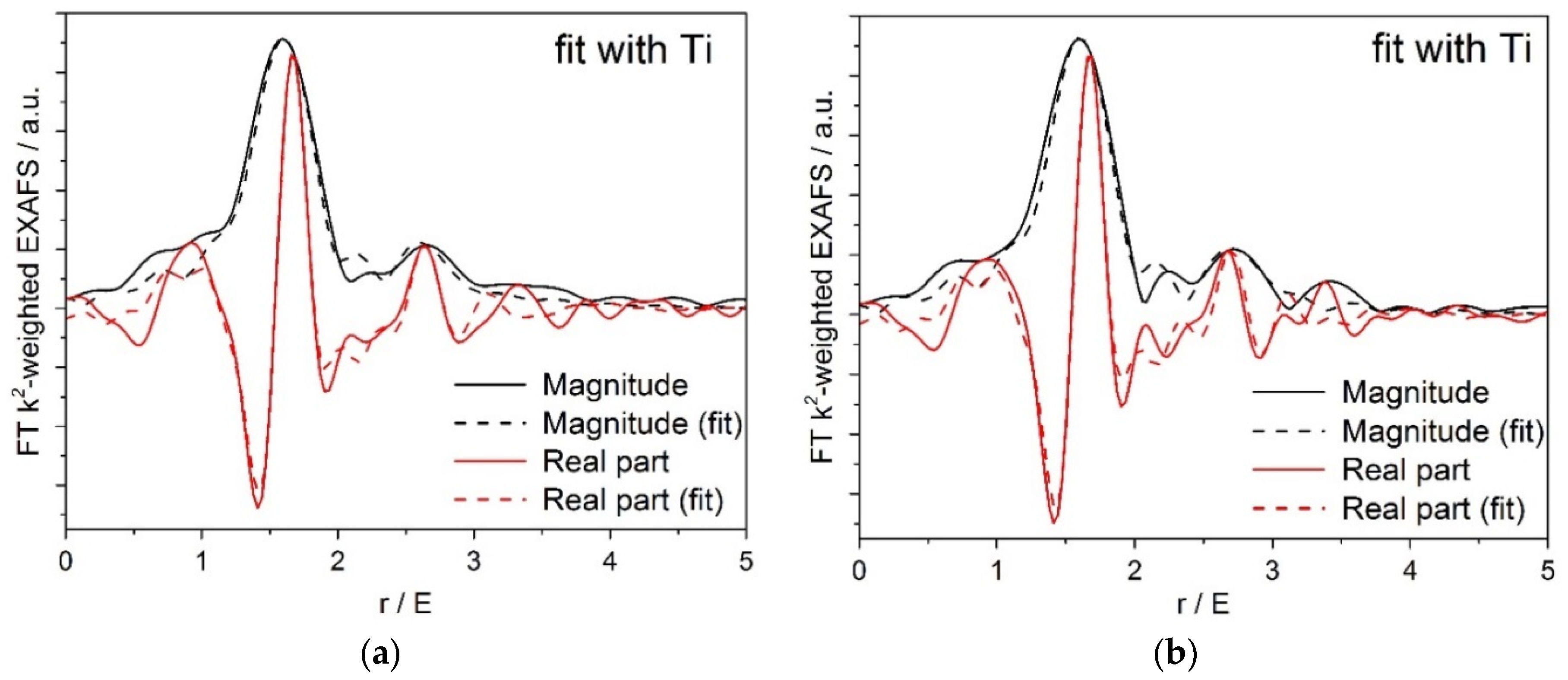
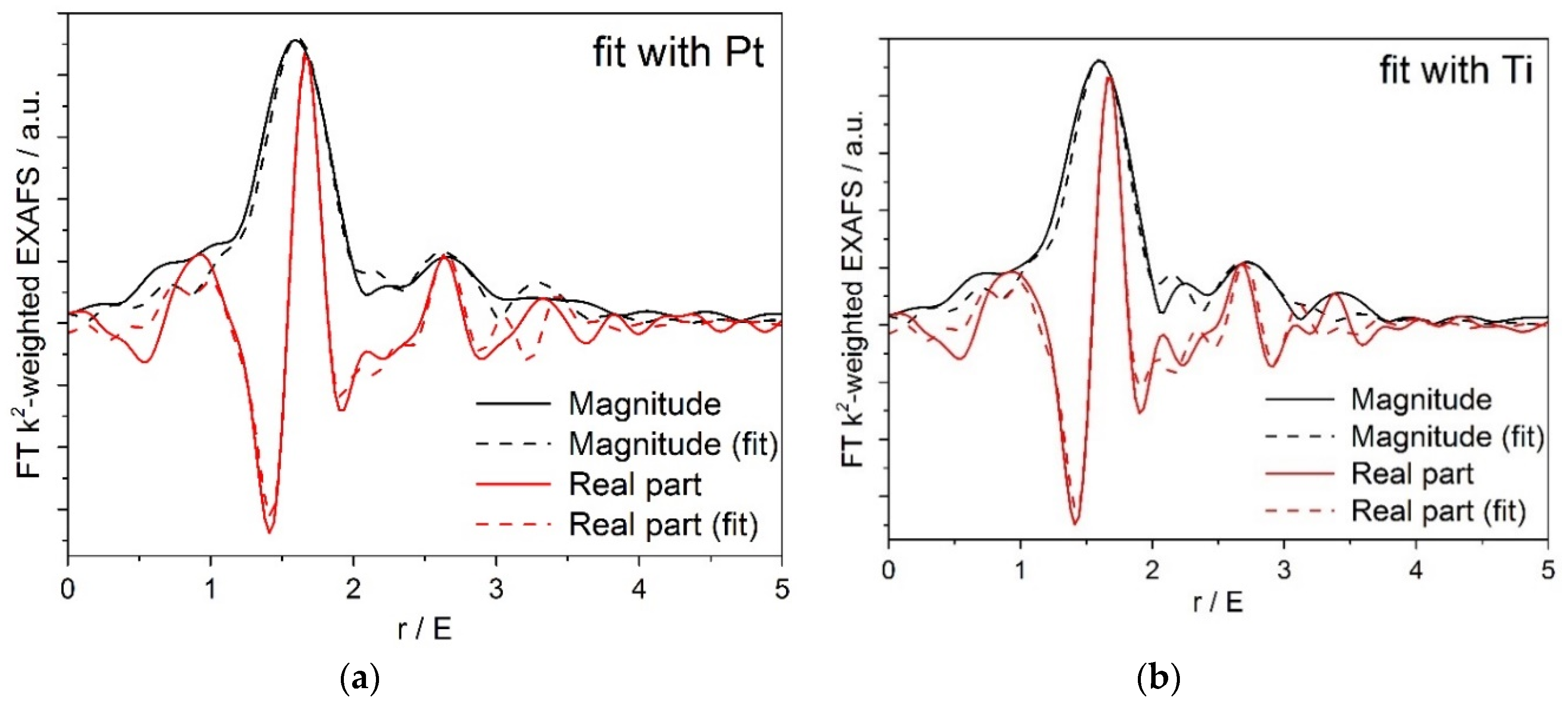
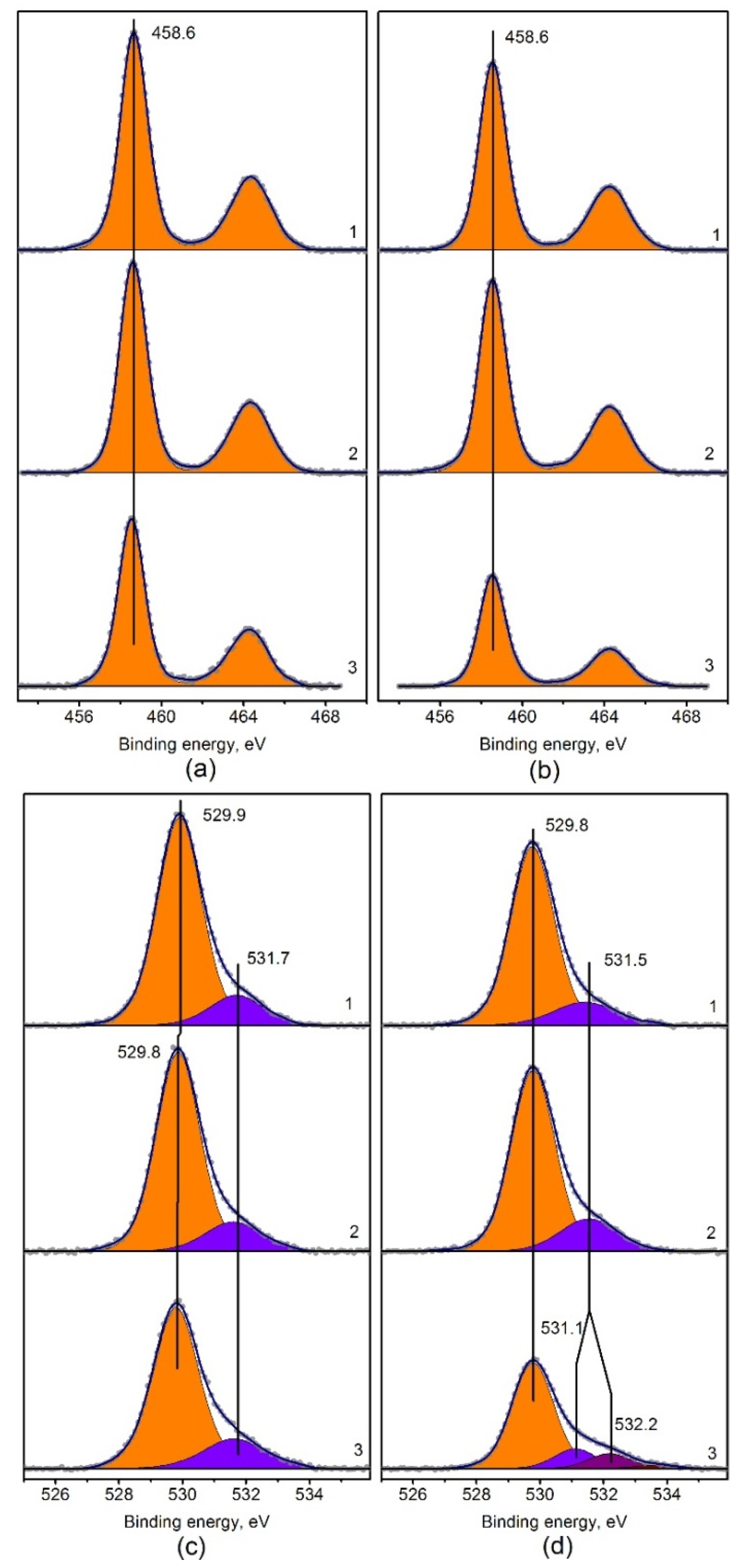
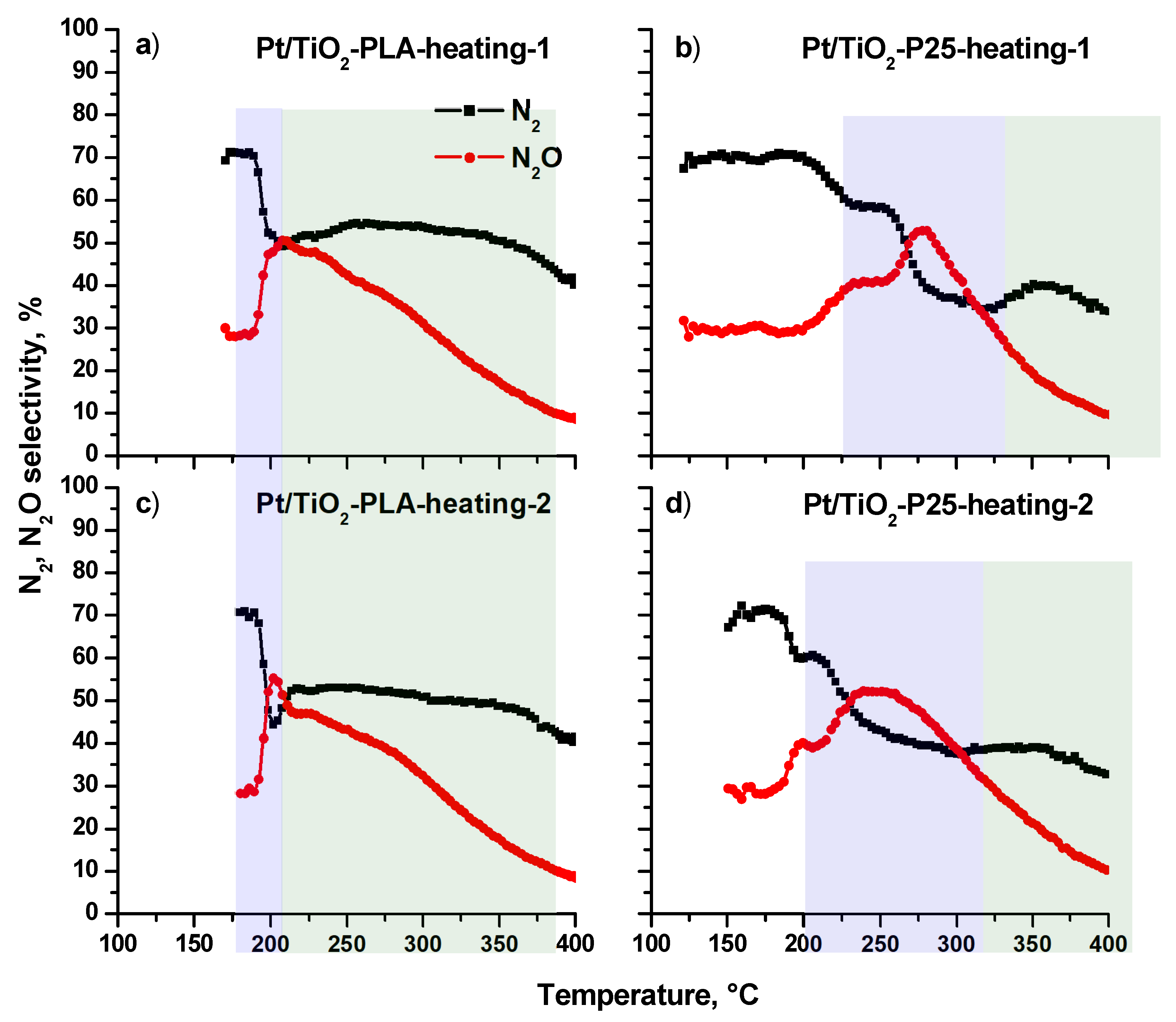
| Sample | TiO2-Anatase | TiO2-Rutile | TiO2-Brookite | Pt | ||||
|---|---|---|---|---|---|---|---|---|
| a, Å | c, Å | a, Å | c, Å | a, Å | b, Å | c, Å | a, Å | |
| Pt/Ti-PLA 400 | 3.785 | 9.511 | 4.593 | 2.959 | 9.19 | 5.438 | 5.143 | - |
| Pt/Ti-PLA 600 | 3.785 | 9.512 | 4.593 | 2.960 | 9.19 | 5.438 | 5.143 | 3.922 |
| Pt/Ti-PLA 800 | 3.784 | 9.515 | 4.593 | 2.959 | - | - | - | 3.923 |
| Pt/Ti-P25-400 | 3.786 | 9.508 | 4.595 | 2.960 | - | - | - | - |
| Pt/Ti-P25-600 | 3.786 | 9.512 | 4.594 | 2.962 | - | - | - | 3.922 |
| Pt/Ti-P25-800 | - | - | 4.593 | 2.960 | - | - | - | 3.923 |
| Catalyst | Pt-O | DW Factor (10−3 Å2) | Pt-Pt | DW Factor (10−3 Å2) | δE0 (eV) | ρ (%) | ||
|---|---|---|---|---|---|---|---|---|
| Distance (Å) | CN | Distance (Å) | CN | |||||
| Pt/Ti-P25 400 | 2.00 ± 0.01 | 6.0 ± 0.6 | 3.9 ± 1.6 | 3.14 ± 0.05 | 9.1 ± 6.3 | 12.2 ± 8.1 | 12.4 ± 1.0 | 0.5 |
| Pt/Ti-PLA 400 | 2.00 ± 0.01 | 5.3 ± 0.6 | 1.6 ± 2.0 | 3.14 ± 0.05 | 4.9 ± 4.0 | 3.7 ± 8.3 | 12.4 ± 2.1 | 1.4 |
| Reaction Temperature, °C | Pt/TiO2-PLA | Pt/TiO2-P25 | ||
|---|---|---|---|---|
| 400 °C | 600 °C | 400 °C | 600 °C | |
| 170–180 | 70.8 | 80.1 | 76.1 | 68.6 |
| 215–225 | 52.4 | 55.8 | 54.0 | 61.8 |
| 260–270 | 52.7 | 41.5 | 32.6 | 40.5 |
| 305–315 | 50.1 | 42.8 | 30.9 | 34.4 |
| 345–355 | 48.7 | 46.1 | 33.9 | 34.1 |
| 385–395 | 41.0 | 45.6 | 31.3 | 32.4 |
References
- Chen, M.S.; Cai, Y.; Yan, Z.; Gath, K.K.; Axnanda, S.; Goodman, D.W. Highly Active Surfaces for CO Oxidation on Rh, Pd, and Pt. Surf. Sci. 2007, 601, 5326–5331. [Google Scholar] [CrossRef]
- Oi-uchisawa, J.; Wang, S.; Nanba, T.; Ohi, A.; Obuchi, A. Improvement of Pt Catalyst for Soot Oxidation Using Mixed Oxide as a Support. Appl. Catal. B Environ. 2003, 44, 207–215. [Google Scholar] [CrossRef]
- Chen, W.; Yamada, J.; Matsumoto, K. Catalytic olefin epoxidation with molecular oxygen over supported amidate- bridged platinum blue complexes. Synth. Commun. 2002, 32, 17–22. [Google Scholar] [CrossRef]
- Chakraborty, D.; Petersen, H.N.; Elkjær, C.; Cagulada, A.; Johannessen, T. Solid Ammonia as Energy Carrier: Current Status and Future Prospects. Fuel Cells Bull. 2009, 12–15. [Google Scholar] [CrossRef]
- Son, I.H.; Shamsuzzoha, M.; Lane, A.M. Promotion of Pt/γ-Al2O3 by New Pretreatment for Low-Temperature Preferential Oxidation of CO in H2 for PEM Fuel Cells. J. Catal. 2002, 210, 460–465. [Google Scholar] [CrossRef]
- Svintsitskiy, D.A.; Kibis, L.S.; Stadnichenko, A.I. Insight into the Nature of Active Species of Pt/Al2O3 Catalysts for Low Temperature NH3 Oxidation. ChemCatChem 2019, 11, 1–15. [Google Scholar] [CrossRef] [Green Version]
- Yu, X.; Ye, S. Recent Advances in Activity and Durability Enhancement of Pt/C Catalytic Cathode in PEMFC Part I. Physico-Chemical and Electronic Interaction between Pt and Carbon Support, and Activity Enhancement of Pt/C Catalyst. J. Power Sources 2007, 172, 133–144. [Google Scholar] [CrossRef]
- Wang, H.; Yang, W.; Tian, P.; Zhou, J.; Tang, R.; Wu, S. Applied Catalysis A: General A Highly Active and Anti-Coking Pd-Pt/SiO2 Catalyst for Catalytic Combustion of Toluene at Low Temperature. Appl. Catal. A Gen. 2017, 529, 60–67. [Google Scholar] [CrossRef]
- Hansen, T.K. Development of New Diesel Oxidation and NH3 Slip Catalysts. Ph.D. Thesis, Technical University of Denmark (DTU), Lyngby, Denmark, 2017. [Google Scholar]
- Bruix, A.; Lykhach, Y.; Matolínová, I.; Neitzel, A.; Skála, T.; Tsud, N.; Vorokhta, M.; Stetsovych, V.; Ševčíková, K.; Mysliveček, J.; et al. Maximum Noble-Metal Efficiency in Catalytic Materials: Atomically Dispersed Surface Platinum. Angew. Chem. Int. Ed. Engl. 2014, 53, 10525–10530. [Google Scholar] [CrossRef]
- An, N.; Yu, Q.; Liu, G.; Li, S.; Jia, M.; Zhang, W. Complete Oxidation of Formaldehyde at Ambient Temperature over Supported Pt/Fe2O3 Catalysts Prepared by Colloid-Deposition Method. J. Hazard. Mater. 2011, 186, 1392–1397. [Google Scholar] [CrossRef]
- Li, F.B.; Li, X.Z. The Enhancement of Photodegradation Efficiency Using Pt–TiO2 Catalyst. Chemosphere 2002, 48, 1103–1111. [Google Scholar] [CrossRef] [Green Version]
- Derevyannikova, E.A.; Kardash, T.Y.; Stadnichenko, A.I.; Stonkus, O.A.; Slavinskaya, E.M.; Svetlichnyi, V.A.; Boronin, A.I. Structural Insight into Strong Pt–CeO2 Interaction: From Single Pt Atoms to PtOx Clusters. J. Phys. Chem. C 2019, 123, 1320–1334. [Google Scholar] [CrossRef]
- Dvorak, F.; Camellone, M.F.; Tovt, A.; Tran, N.; Negreiros, F.R.; Vorokhta, M.; Skala, T.; Matolinova, I.; Myslivecek, J.; Matolin, V.; et al. Creating Single-Atom Pt-Ceria Catalysts by Surface Step Decoration. Nat. Commun. 2016, 7. [Google Scholar] [CrossRef]
- Kunwar, D.; Zhou, S.; Delariva, A.; Peterson, E.J.; Xiong, H.; Purdy, S.C.; Veen, R.; Brongersma, H.H.; Pereira-Herna, X.I.; Miller, T.; et al. Stabilizing High Metal Loadings of Thermally Stable Platinum Single Atoms on an Industrial Catalyst Support. ACS Catal. 2019, 9, 3978–3990. [Google Scholar] [CrossRef]
- Boubnov, A.; Dahl, S.; Johnson, E.; Molina, A.P.; Simonsen, S.B.; Cano, F.M.; Helveg, S.; Lemus-Yegres, L.J.; Grunwaldt, J.-D. Structure-Activity Relationships of Pt/Al2O3 Catalysts for CO and NO Oxidation at Diesel Exhaust Conditions. Appl. Catal. B Environ. 2012, 126, 315–325. [Google Scholar] [CrossRef]
- Stakheev, A.Y.; Bokarev, D.A.; Prosvirin, I.P.; Bukhtiyarov, V.I. Particle-Size Effect in Catalytic Oxidation Over Pt. Nanoparticles; Sadykov, V.A., Ed.; Elsevier Inc.: Amsterdam, The Netherlands, 2019. [Google Scholar] [CrossRef]
- Hsieh, B.; Tsai, M.; Pan, C.; Su, W.; Rick, J.; Chou, H.; Lee, J.; Hwang, B. Electrochimica Acta Tuning Metal Support Interactions Enhances the Activity and Durability of TiO2-Supported Pt Nanocatalysts. Electrochim. Acta 2017, 224, 452–459. [Google Scholar] [CrossRef]
- Lee, J.; Song, I.; Heui, D. Suppressed Strong Metal—Support Interactions in Platinum on Sulfated Titania and Their Influence on the Oxidation of Carbon Monoxide. ChemCatChem 2018, 10, 1258–1262. [Google Scholar] [CrossRef]
- Wang, D.; Huang, J.; Liu, F.; Xu, X.; Fang, X.; Liu, J. Rutile RuO2 Dispersion on Rutile and Anatase TiO2 Supports: The Effects of Support Crystalline Phase Structure on the Dispersion Behaviors of the Supported Metal Oxides. Catal. Today 2020, 339, 220–232. [Google Scholar] [CrossRef]
- Hegde, M.S.; Madras, G.; Patil, K.C. Noble Metal Ionic Catalysts. Acc. Chem. Res. 2009, 42, 704–712. [Google Scholar] [CrossRef]
- Mukri, B.D.; Waghmare, U.V.; Hegde, M.S. Platinum Ion-Doped TiO2: High Catalytic Activity of Pt2+ with Oxide Ion Vacancy in Ti4+1−xPt2+xO2−x Compared to Pt4+ without Oxide Ion Vacancy in Ti4+1−xPt4+xO2. Chem. Mater. 2013, 25, 3822–3833. [Google Scholar] [CrossRef]
- Teoh, W.Y.; Mädler, L.; Beydoun, D.; Pratsinis, S.E.; Amal, R. Direct (One-Step) Synthesis of TiO2 and Pt/TiO2 Nanoparticles for Photocatalytic Mineralisation of Sucrose. Chem. Eng. Sci. 2005, 60, 5852–5861. [Google Scholar] [CrossRef]
- Strobel, R.; Baiker, A.; Pratsinis, S.E. Aerosol Flame Synthesis of Catalysts. Adv. Powder Technol. 2006, 17, 457–480. [Google Scholar] [CrossRef]
- Bera, P.; Hegde, M.S. Noble Metal Ions in CeO2 and TiO2: Synthesis, Structure and Catalytic Properties. RSC Adv. 2015, 5, 94949–94979. [Google Scholar] [CrossRef]
- Kelly, P.J.; Hisek, J.; Zhou, Y.; Pilkington, R.D.; Arnell, R.D. Advanced Coatings through Pulsed Magnetron Sputtering. Surf. Eng. 2004, 20, 157–162. [Google Scholar] [CrossRef] [Green Version]
- Moret, M.P.; Zallen, R.; Vijay, D.P.; Desu, S.B. Brookite-Rich Titania Films Made by Pulsed Laser Deposition. Thin Solid Films 2000, 366, 8–10. [Google Scholar] [CrossRef]
- Liu, P.; Cai, W.; Fang, M.; Li, Z.; Zeng, H.; Hu, J.; Luo, X.; Jing, W. Room Temperature Synthesized Rutile TiO 2 Nanoparticles Induced by Laser Ablation in Liquid and Their Photocatalytic Activity. Nanotechnology 2009, 20, 1–7. [Google Scholar] [CrossRef]
- Siuzdak, K.; Sawczak, M.; Klein, M.; Nowaczyk, G.; Jurga, S.; Cenian, A. Preparation of Platinum Modified Titanium Dioxide Nanoparticles with the Use of Laser Ablation in Water. Phys. Chem. Chem. Phys. 2014, 16, 15199–15206. [Google Scholar] [CrossRef]
- Slavinskaya, E.M.; Stadnichenko, A.I.; Muravyov, V.V.; Kardash, T.Y.; Derevyannikova, E.A.; Zaikovskii, V.I.; Stomkus, O.A.; Lapin, I.N.; Svetlichnyi, V.A.; Boronin, A.I. Transformation of a Pt–CeO2 Mechanical Mixture of Pulsed-Laser-Ablated Nanoparticles to a Highly Active Catalyst for Carbon Monoxide Oxidation. ChemCatChem 2018, 10, 2232–2247. [Google Scholar] [CrossRef]
- Fedorova, E.A.; Stadnichenko, A.I.; Slavinskaya, E.M.; Kibis, L.S.; Stonkus, O.A.; Svintsitskiy, D.A.; Lapin, I.N.; Romanenko, A.V.; Svetlichnyi, V.A.; Boronin, A.I. A Study of PtAl2O3 Nanocomposites Obtained by Pulsed Laser Ablation to Be Used as Catalysts of Oxidation Reactions. J. Struct. Chem. 2020, 61, 332–346. [Google Scholar]
- Ogel, E.; Casapu, M.; Doronkin, D.E.; Popescu, R.; Störmer, H.; Mechler, C.; Marzun, G.; Barcikowski, S.; Türk, M.; Grunwaldt, J.-D. Impact of Preparation Method and Hydrothermal Aging on Particle Size Distribution of Pt/γ-Al2O3 and Its Performance in CO and NO Oxidation. J. Phys. Chem. C 2019, 123, 5433–5446. [Google Scholar] [CrossRef]
- TOPAS; Bruker AXS Inc.: Madison, WI, USA, 2009.
- Ravel, B.; Newville, M. ATHENA, ARTEMIS, HEPHAESTUS: Data Analysis for X-Ray Absorption Spectroscopy Using IFEFFIT. J. Synchrotron Radiat. 2005, 12, 537–541. [Google Scholar] [CrossRef] [PubMed] [Green Version]
- Bertoti, I.; Mohai, M.; Sullivan, J.L.; Saied, S.O. Surface Characterisation of Plasma-Nitrided Titanium: An XPS Study. Appl. Surf. Sci. 1995, 84, 357–371. [Google Scholar] [CrossRef]
- Svintsitskiy, D.A.; Kibis, L.S.; Stadnichenko, A.I.; Koscheev, S.V.; Zaikovskii, V.I.; Boronin, A.I. Highly Oxidized Platinum Nanoparticles Prepared through Radio-Frequency Sputtering: Thermal Stability and Reaction Probability towards CO. ChemPhysChem 2015, 16, 3318–3324. [Google Scholar] [CrossRef] [PubMed]
- Schneider, C.A.; Rasband, W.S.; Eliceiri, K.W. HISTORICAL Commentary NIH Image to ImageJ: 25 Years of Image Analysis. Nat. Methods 2012, 9, 671–675. [Google Scholar] [CrossRef] [PubMed]
- Scarisoreanu, M.; Ilie, A.; Dutu, E.; Badoi, A.; Dumitrache, F.; Tanasa, E.; Mihailescu, C.N.; Mihailescu, I. Applied Surface Science Direct Nanocrystallite Size Investigation in Microstrained Mixed Phase TiO2 Nanoparticles by PCA of Raman Spectra. Appl. Surf. Sci. 2019, 470, 507–519. [Google Scholar] [CrossRef]
- Vovk, E.I.; Kalinkin, A.V.; Smirnov, M.Y.; Klembovskii, I.O.; Bukhtiyarov, V.I. XPS Study of Stability and Reactivity of Oxidized Pt Nanoparticles Supported on TiO2. J. Phys. Chem. C 2017, 121, 17297–17304. [Google Scholar] [CrossRef]
- Bruix, A.; Rodriguez, J.A.; Ramirez, P.J.; Senanayake, S.D.; Evans, J.; Park, J.B.; Stacchiola, D.; Liu, P.; Hrbek, J.; Illas, F. A New Type of Strong Metal − Support Interaction and the Production of H2 through the Transformation of Water on Pt/CeO2(111) and Pt/CeOx/TiO2(110) Catalysts. J. Am. Chem. Soc. 2012, 134, 8968–8974. [Google Scholar] [CrossRef]
- Lykhach, Y.; Kozlov, S.M.; Skála, T.; Tovt, A.; Stetsovych, V.; Tsud, N.; Dvořák, F.; Johánek, V.; Neitzel, A.; Mysliveček, J.; et al. Counting Electrons on Supported Nanoparticles. Nat. Mater. 2016, 15, 284–288. [Google Scholar] [CrossRef]
- Svintsitskiy, D.A.; Kibis, L.S.; Stadnichenko, A.I.; Slavinskaya, E.M.; Zaguzin, A.S.; Romanenko, A.V.; Derevyannikova, E.A.; Stonkus, O.A.; Boronin, A.I. The Influence of the Metal-Support Interaction on the Catalytic Activity of Pt/Al2O3 and Pt/TiO2 in NH3 Oxidation. AIP Conf. Proc. 2143 2019, 20028, 1–5. [Google Scholar] [CrossRef]
- Ivanova, E.; Mihaylov, M.; Daturi, M.; Hadjiivanov, K. FTIR Spectroscopy Study of CO and NO Adsorption and Co-Adsorption on Pt/TiO2. J. Mol. Catal. A Chem. 2007, 274, 179–184. [Google Scholar] [CrossRef]
- Seriani, N.; Pompe, W.; Ciacchi, L.C. Catalytic Oxidation Activity of Pt3O4 Surfaces and Thin Films. J. Phys. Chem. B 2006, 110, 14860–14869. [Google Scholar] [CrossRef] [PubMed]
- Fung, S.C. XPS Studies of Strong Metal-Support Interactions (SMSI)-Pt/TiO2. J. Catal. 1982, 76, 225–230. [Google Scholar] [CrossRef]
- Ioannides, T.; Verykios, X.E. Charge Transfer in Metal Catalysts Supported on Doped TiO2: A Theoretical Approach Based on Metal—Semiconductor Contact Theory. J. Catal. 1996, 161, 560–569. [Google Scholar] [CrossRef]
- Bahl, M.K.; Tsai, S.C.; Chung, Y.W. Auger and Photoemission Investigations of the Platinum-SrTiO3(100) Interface: Relaxation and Chemical-Shift Effects. Phys. Rev. B 1980, 21, 1344–1348. [Google Scholar] [CrossRef]
- Sexton, B.A.; Hughes, A.E.; Foger, K. XPS Investigation of Strong Metal-Support Interactions on Group IIIa-Va Oxides. J. Catal. 1982, 77, 85–93. [Google Scholar] [CrossRef]
- Moulder, J.F.; Strickle, W.F.; Sobol, P.E.; Bomben, K.D. A Reference Book of Standart Spectra for Identification and Interpretation of XPS Data; Chastain, J., Ed.; Perkin-Elmer Corporation Physical Electronics Division: Eden Prairie, MN, USA, 1992. [Google Scholar]
- Jehn, H. High Temperature Behaviour of Platinum Group Metals in Oxidizing Atmospheres. J. Less-Common Met. 1984, 100, 321–339. [Google Scholar] [CrossRef]
- Kraehnert, R.; Baerns, M. Kinetics of Ammonia Oxidation over Pt Foil Studied in a Micro-Structured Quartz-Reactor. Chem. Eng. J. 2008, 137, 361–375. [Google Scholar] [CrossRef] [Green Version]
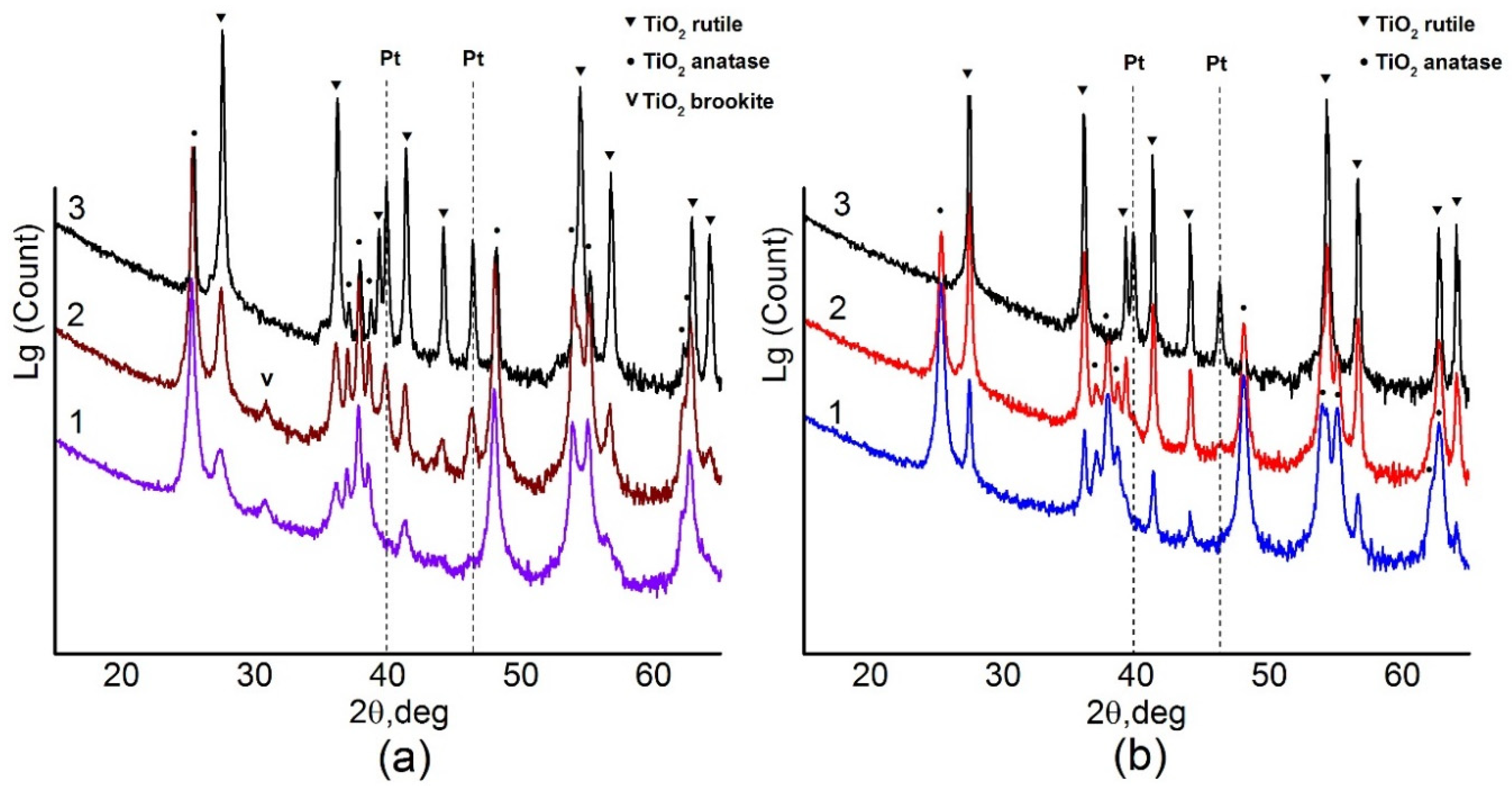
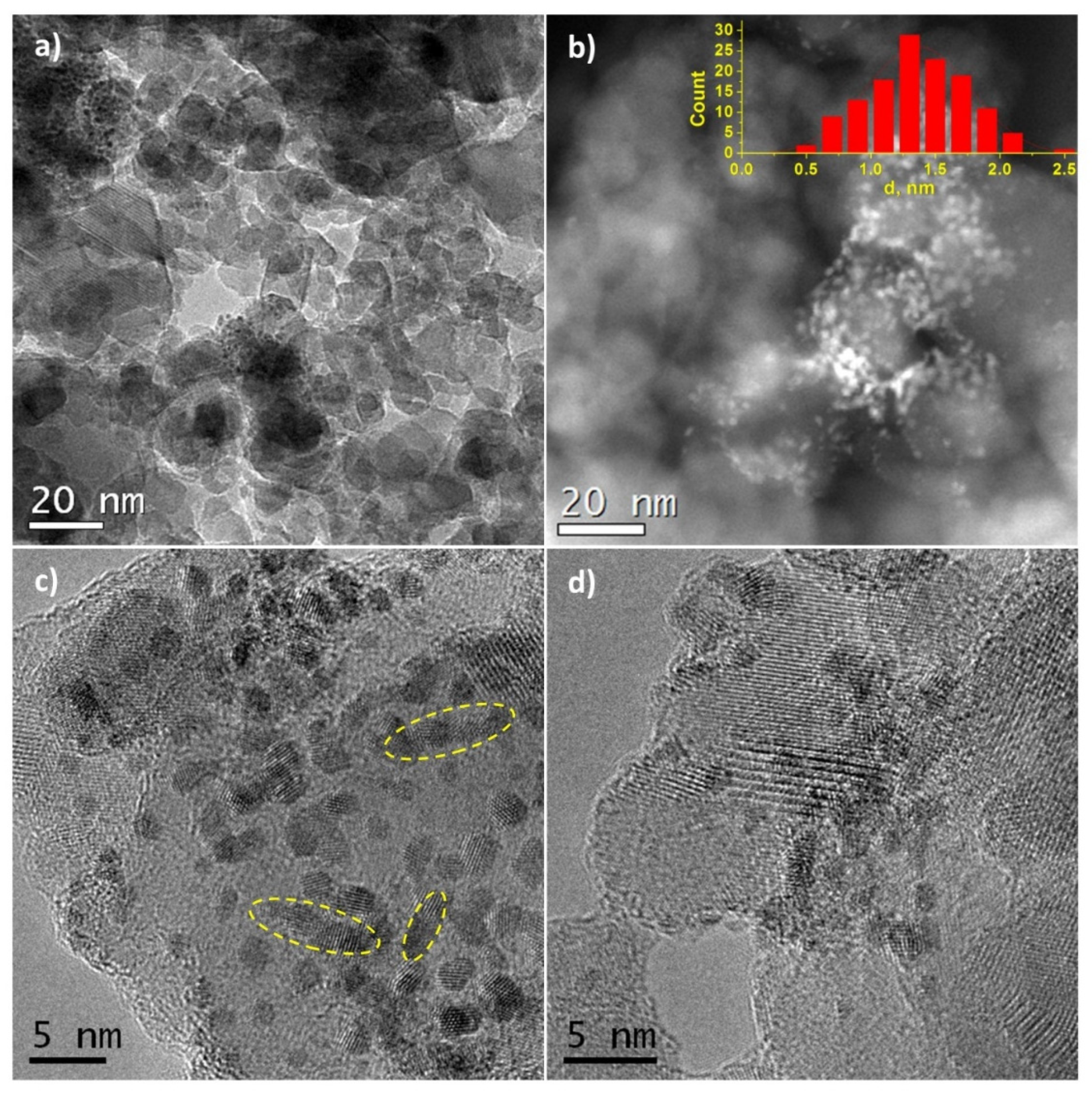

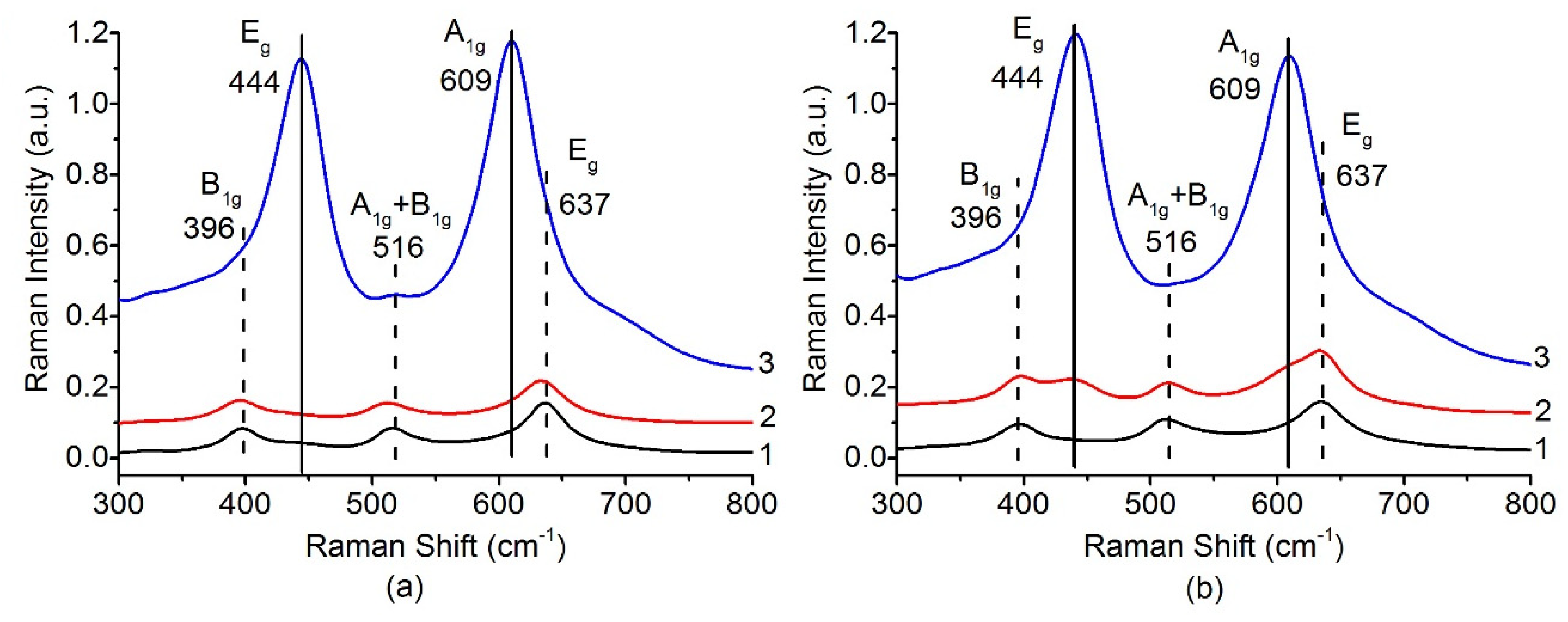
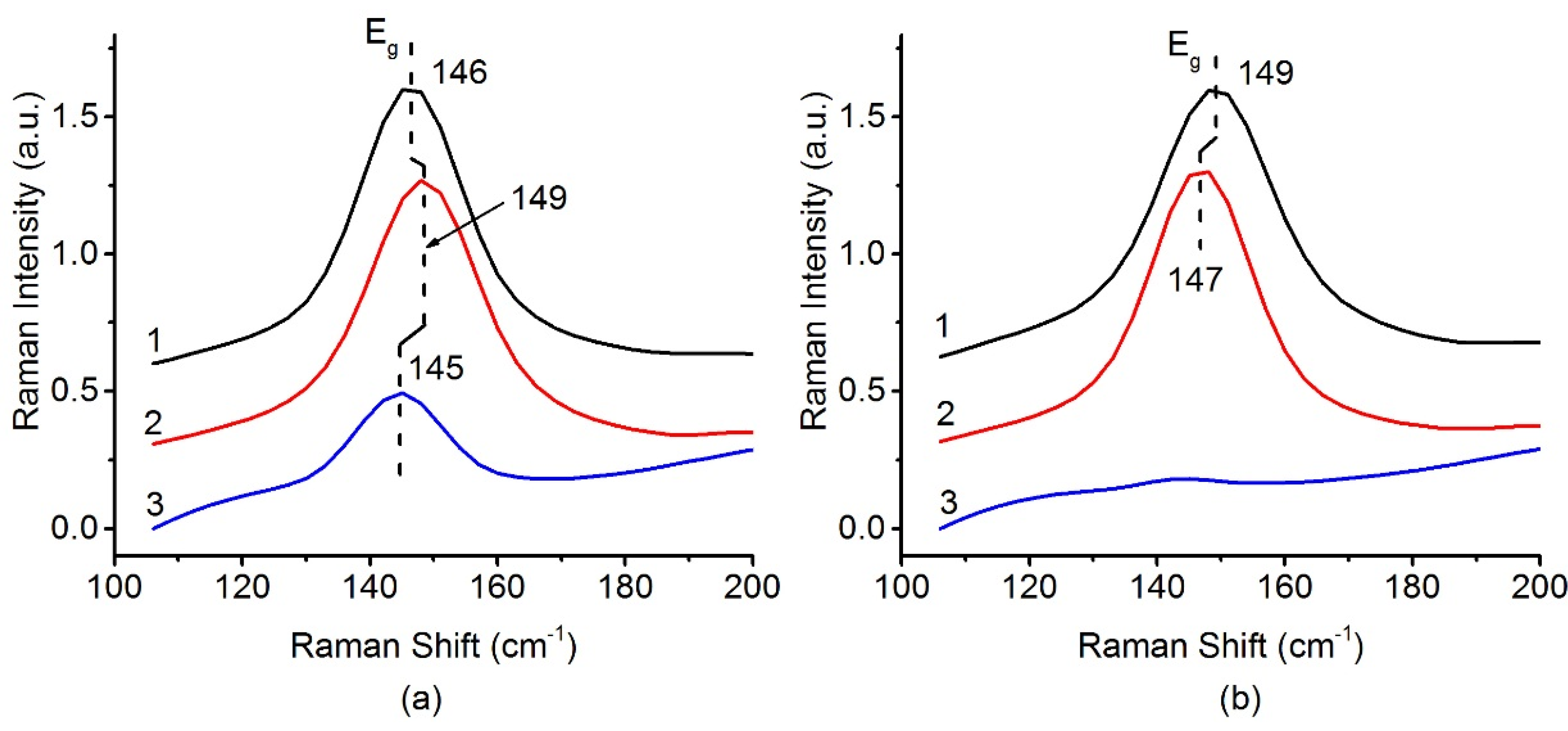




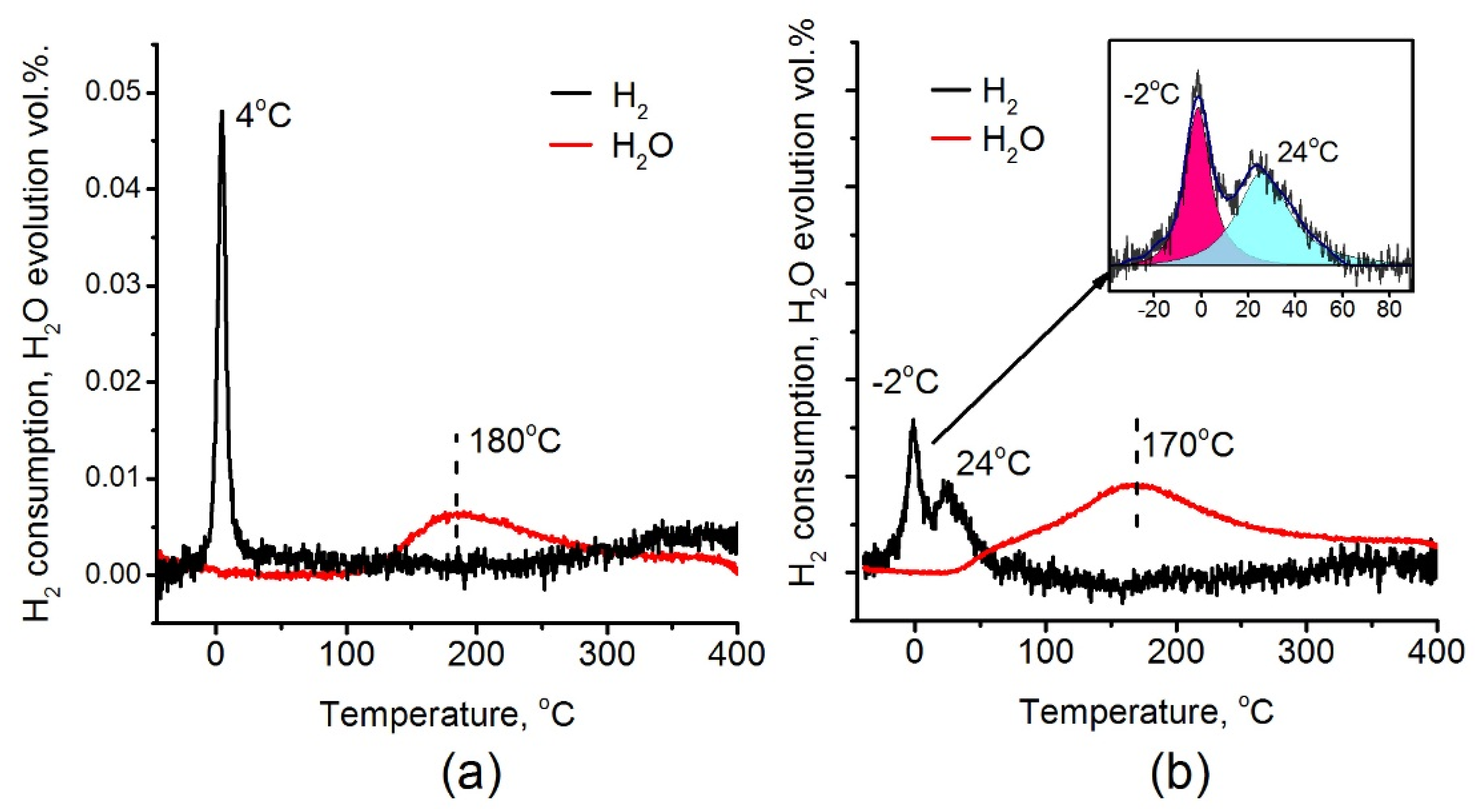

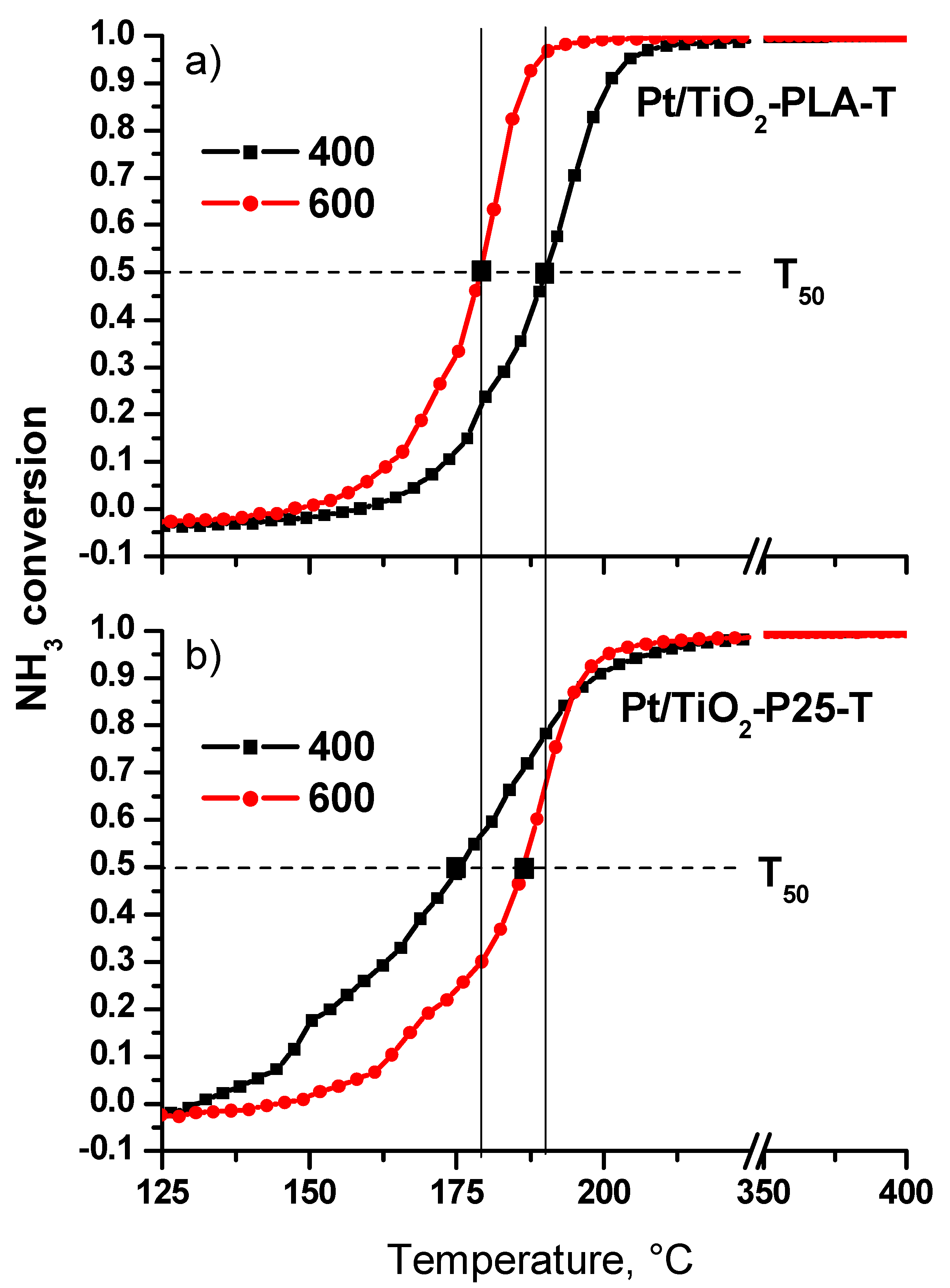

| Sample | BET Surface Area, m2/g | TiO2-Anatase | TiO2-Rutile | TiO2-Brookite | Pt | ||||
|---|---|---|---|---|---|---|---|---|---|
| D, nm | wt. % | D, nm | wt. % | D, nm | wt. % | D, nm | wt. % | ||
| Pt/Ti-PLA 400 | 79 | 21.6 | 66 | 7.3 | 19 | 5 | 15 | - | 0 |
| Pt/Ti-PLA 600 | 64 | 30 | 68 | 13 | 26 | 7 | 5 | 16 | 0.8 |
| Pt/Ti-PLA 800 | - | 60 | 11.8 | 62 | 86.8 | - | 0 | 48 | 1.4 |
| Pt/Ti-P25-400 | 63 | 18.8 | 84 | 29 | 16 | - | 0 | - | 0 |
| Pt/Ti-P25-600 | 29 | 22.4 | 38.8 | 44 | 61 | - | 0 | 11 | 0.2 |
| Pt/Ti-P25-800 | 1.6 | - | 0 | 114 | 98.7 | - | 0 | 36 | 1.3 |
| Catalyst | Pt-O (First Shell) | DW Factor (10-3 Å2) | Pt-Ti (Second Shell) | DW Factor (10-3 Å2) | δE0 (eV) | ρ (%) | ||
|---|---|---|---|---|---|---|---|---|
| Distance (Å) | CN | Distance (Å) | CN | |||||
| Pt/Ti-P25 400 | 2.00 ± 0.01 | 5.8 ± 0.7 | 3.9 ± 1.9 | 3.11 ± 0.05 | 2.9 ± 2.5 | 10.4 ± 10.5 | 12.4 ± 1.1 | 0.6 |
| Pt/Ti-PLA 400 | 2.01 ± 0.01 | 5.7 ± 0.9 | 3.1 ± 2.4 | 3.16 ± 0.05 | 2.3 ± 2.6 | 6.0 ± 11.9 | 12.2 ± 1.4 | 1.0 |
| Element | Binding Energy, eV | Interpretation | Pt/Ti-PLA | Pt/Ti-P25 | ||||
|---|---|---|---|---|---|---|---|---|
| 400 °C | 600 °C | 800 °C | 400 °C | 600 °C | 800 °C | |||
| Pt4f | 0.58 | 0.16 | 0.20 | 0.41 | 0.11 | 0.15 | ||
| 70.6–70.9 | Pt0 | 0 | 0.06 | 0.15 | 0 | 0.03 | 0.11 | |
| 71.7–73.1 | Pt2+ | 0.28 | 0 | 0 | 0.26 | 0.02 | 0.04 | |
| 73.7–74.9 | Pt4+ | 0.30 | 0.10 | 0.05 | 0.15 | 0.06 | 0.00 | |
| Pt/Ti | 0.028 | 0.008 | 0.010 | 0.021 | 0.005 | 0.010 | ||
| Ti2p | 458.6 | Ti4+ | 21.0 | 20.3 | 18.2 | 20.3 | 20.4 | 14.7 |
| O1s | 57.2 | 55.3 | 56.0 | 54.6 | 55.6 | 44.3 | ||
| 529.9–530.0 | Ti-Olatice | 48.8 | 46.5 | 45.0 | 46.0 | 45.1 | 32.5 | |
| 531.5–531.7 | Ti-Oads | 8.4 | 8.8 | 11.0 | 8.6 | 10.5 | 11.8 | |
| C1s | 21.2 | 24.2 | 25.6 | 24.7 | 23.9 | 40.8 | ||
| 285.1–285.2 | C-C. C-H | 19.3 | 21.5 | 23.9 | 22.5 | 20.5 | 38.5 | |
| 288.3–288.6 | COx | 1.9 | 2.7 | 1.7 | 2.2 | 3.4 | 2.3 | |
| Binding Energy, eV | Description | Pt/Ti-PLA-400 | Pt/Ti-P25-400 | ||
|---|---|---|---|---|---|
| Initial | After Reaction | Initial | After Reaction | ||
| 70.6–70.9 | Pt0 | 0 | 60 | 0 | 72 |
| 72.3–73.1 | Pt2+ | 48 | 29 | 63 | 28 |
| 73.7, 74.3–74.7 | Pt4+ | 52 | 11 | 37 | 0 |
© 2020 by the authors. Licensee MDPI, Basel, Switzerland. This article is an open access article distributed under the terms and conditions of the Creative Commons Attribution (CC BY) license (http://creativecommons.org/licenses/by/4.0/).
Share and Cite
Stadnichenko, A.; Svintsitskiy, D.; Kibis, L.; Fedorova, E.; Stonkus, O.; Slavinskaya, E.; Lapin, I.; Fakhrutdinova, E.; Svetlichnyi, V.; Romanenko, A.; et al. Influence of Titania Synthesized by Pulsed Laser Ablation on the State of Platinum during Ammonia Oxidation. Appl. Sci. 2020, 10, 4699. https://doi.org/10.3390/app10144699
Stadnichenko A, Svintsitskiy D, Kibis L, Fedorova E, Stonkus O, Slavinskaya E, Lapin I, Fakhrutdinova E, Svetlichnyi V, Romanenko A, et al. Influence of Titania Synthesized by Pulsed Laser Ablation on the State of Platinum during Ammonia Oxidation. Applied Sciences. 2020; 10(14):4699. https://doi.org/10.3390/app10144699
Chicago/Turabian StyleStadnichenko, Andrey, Dmitry Svintsitskiy, Lidiya Kibis, Elizaveta Fedorova, Olga Stonkus, Elena Slavinskaya, Ivan Lapin, Elena Fakhrutdinova, Valery Svetlichnyi, Anatoly Romanenko, and et al. 2020. "Influence of Titania Synthesized by Pulsed Laser Ablation on the State of Platinum during Ammonia Oxidation" Applied Sciences 10, no. 14: 4699. https://doi.org/10.3390/app10144699







